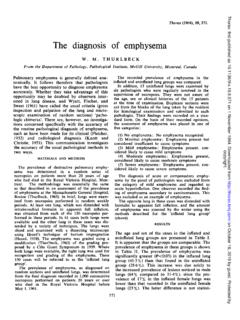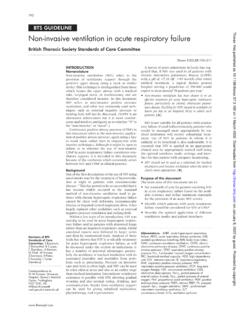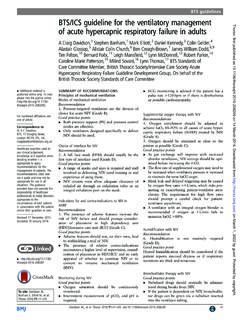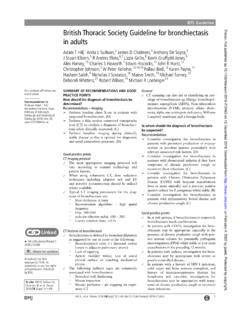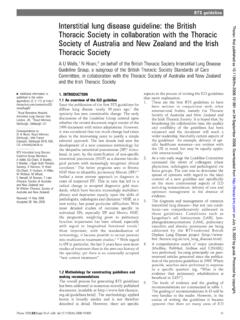Transcription of BTS guidelines British Thoracic Society guidelines for the ...
1 British Thoracic Society guidelines for theinvestigation and management of pulmonary nodulesM E J Callister,1D R Baldwin,2A R Akram,3S Barnard,4P Cane,5J Draffan,6K Franks,7F Gleeson,8R Graham,9P Malhotra,10M Prokop,11K Rodger,12M Subesinghe,13D Waller,14I Woolhouse,15 British Thoracic Society PulmonaryNodule Guideline Development Group, on behalf of the British Thoracic SocietyStandards of Care Committee Additional material ispublished online only. To viewplease visit the journal online( ).For numbered affiliations seeend of toProfessor David R Baldwin,Nottingham UniversityHospitals and University ofNottingham, RespiratoryMedicine Unit, David EvansResearch Centre, NottinghamUniversity Hospitals,Nottingham City HospitalCampus, NottinghamNG5 1PB, 14 April 2015 Accepted 16 April 2015To cite:Callister MEJ,Baldwin DR, Akram AR,et ;70:ii1 OF RECOMMENDATIONSThis guideline is based on a comprehensive reviewof the literature on pulmonary nodules and expertopinion. Although the management pathway forthe majority of nodules detected is straightforwardit is sometimes more complex and this is helped bythe inclusion of detailed and specific recommenda-tions and the 4 management algorithms below.
2 TheGuideline Development Group (GDG) wanted tohighlight the new research evidence which has ledto significant changes in management recommenda-tions from previously published include the use of two malignancy predictioncalculators (section Initial assessment of the prob-ability of malignancy in pulmonary nodules , algo-rithm 1) to better characterise risk of are recommendations for a higher nodulesize threshold for follow-up ( 5mmor 80 mm3)and a reduction of the follow-up period to 1 year forsolid pulmonary nodules; both of these willreduce the number of follow-up CT scans (sections Initial assessment of the probability of malignancy inpulmonary nodules and Imaging follow-up ,algo-rithms 1 and 2). Volumetry is recommended as thepreferred measurement method and there are recom-mendations for the management of nodules withextended volume doubling times (section Imagingfollow-up , algorithm 2). Acknowledging the goodprognosis of sub-solid nodules (SSNs), there arerecommendations for less aggressive options fortheir management (section management of SSNs ,algorithm 3).
3 The guidelines provide more clarity in the use offurther imaging, with ordinal scale reporting forPET-CT recommended to facilitate incorporationinto risk models (section Further imaging in manage-ment of pulmonary nodules ) and more clarity aboutthe place of biopsy (section Non-imaging tests andnon-surgical biopsy , algorithm 4). There are recom-mendations for the threshold for treatment withouthistological confirmation (sections Surgical excisionbiopsy and Non-surgical treatment without patho-logical confirmation of malignancy , algorithm 4).Finally, and possibly most importantly, there areevidence-based recommendations about the infor-mation that people need and which should be pro-vided. This document is intended to be used bothas a summary in the day to day management of aperson with a pulmonary nodule and a comprehen-sive reference of detection of pulmonary nodules Use the same diagnostic approach for nodulesdetected incidentally as those detected D Consider using the presence of previous malig-nancy as a factor in the risk assessment forfurther D Do not prioritise management of pulmonarynodules according to the route of D Evaluate coexistent lung nodules detected inpatients with known lung cancer otherwise suit-able for radical treatment in their own right.
4 They should not be assumed to be DInitial assessment of the probability of malignancyin pulmonary nodules Do not offer nodule follow-up or further investi-gation for people with nodules with diffuse,central, laminated or popcorn pattern of calcifi-cation or macroscopic C Do not offer nodule follow-up or further inves-tigation for people with typical perifissural orsubpleural nodules (homogeneous, smooth,solid nodules with a lentiform or triangularshape either within 1 cm of afissure or thepleural surface and <10 mm).Grade C Consider follow-up of larger intrapulmonarylymph nodes, especially in the presence of aknown extrapulmonary primary D Do not offer nodule follow-up for people withnodules <5 mm in maximum diameter or<80 C Offer CT surveillance to people with nodules 5 mm to <8 mm maximum diameter or 80 mm3to <300 C Use composite prediction models based on clin-ical and radiological factors to estimate theprobability that a pulmonary nodule ( 8mmor 300 mm3) is C Use the Brock model (full, with spiculation) forinitial risk assessment of pulmonary nodules( 8mm or 300 mm3) at presentation inpeople aged 50 who are smokers or C Consider the Brock model (full, with spiculation)for initial risk assessment of pulmonary nodules( 8mmor 300 mm3) in all patients at DCallister MEJ,et ;70:ii1 ii54.
5 guidelines on February 2, 2022 by guest. Protected by : first published as on 16 June 2015. Downloaded from on February 2, 2022 by guest. Protected by : first published as on 16 June 2015. Downloaded from on February 2, 2022 by guest. Protected by : first published as on 16 June 2015. Downloaded from Base the risk assessment of people with multiple pulmonarynodules on that of the largest C Nodule malignancy risk prediction models should be validatedin patients with known extrapulmonary Further analysis of variation in volumetry measurements bydifferent software packages should be undertaken andmethods developed for follow-up Where initial risk stratification assigns a nodule a chance ofmalignancy of <10%, assess growth rate using interval CTwith capability for automated volumetric C Assess growth for nodules 80 mm3or 6 mm maximumdiameter by calculating volume doubling time (VDT) on thebasis of repeat CTat 3 months and 1 C Use a 25% volume change to define significant C Assess growth for nodules of 5 to <6 mm maximum diam-eter by calculating VDT on the basis of repeat CT at 1 C Offer further diagnostic investigation (biopsy, imaging orresection)
6 For patients with nodules showing clear growth ora VDT of <400 days (assessed after 3 months, and 1 year).Grade C Discharge patients with solid nodules that show stability(<25% change in volume) on CTafter 1 C If two-dimensional diameter measurements are used to assessgrowth, follow-up with CT for a total of 2 D Consider ongoing yearly surveillance or biopsy for peoplewith nodules that have a VDT of 400 600 days, according topatient C Consider discharge or ongoing CT surveillance for peoplewho have nodules with a VDT of >600 days, taking intoaccount patient preference and clinical factors such asfitnessand C Where nodules are detected in association with an extrapul-monary primary cancer, consider the growth rate in thecontext of the primary and any treatment DManagement of sub-solid nodules (SSNs) Do not follow-up SSNs that are <5 mm in maximum diam-eter at C Reassess all SSNs with a repeat thin-section CT at 3 DFigure 1 Initial approach to solid pulmonary MEJ,et ;70:ii1 ii54.
7 guidelines on February 2, 2022 by guest. Protected by : first published as on 16 June 2015. Downloaded from Use the Brock risk prediction tool to calculate risk of malignancyin SSNs 5 mm that are unchanged at 3 C Consider using other factors to further refine the estimate ofrisk of malignancy, including smoking status, peripheraleosinophilia, history of lung cancer, size of solid component,bubble-like appearance and pleural D Offer repeat low-dose, thin-section CT at 1, 2 and 4 yearsfrom baseline where the risk of malignancy is approximately<10%.Grade D Discuss the options of observation with repeat CT,CT-guided biopsy, or resection/non-surgical treatment withthe patient where the risk of malignancy is approximately>10%; consider factors such as age, comorbidities and riskof D Consider using changes in mass of SSNs to accurately D Consider resection/non-surgical treatment or observation forpure ground-glass nodules (pGGNs) that enlarge 2mm inmaximum diameter; if observed, repeat CT after a maximumof 6 months.
8 Take into account patient choice, age,comorbidities and risk of D Favour resection/non-surgical treatment over observation forpart-solid nodules (PSNs) that show enlargement of the solidcomponent, or for pGGNs that develop a solid into account patient choice, age, comorbidities and riskof D Favour resection/non-surgical treatment over observationwhere malignancy is pathologically proven. Take intoaccount patient choice, age, comorbidities and risk DFurther imaging in management of pulmonary nodules Offer a PET-CT scan to patients with a pulmonary nodulewith an initial risk of malignancy of >10% (Brock model)where the nodule size is greater than the local PET-CT detec-tion B Ensure that PET-CT reports include the method of D Use qualitative assessment with an ordinal scale to defineFDG uptake as absent, faint, moderate or high using the fol-lowing guide: Absent uptake indiscernible from background lung tissue Faint uptake less than or equal to mediastinal blood pool Moderate uptake greater than mediastinal blood pool Intense uptake markedly greater than mediastinal D Reassess risk after PET-CT using the Herder prediction B After reassessment of risk: Consider CT surveillance for people who have noduleswith a chance of malignancy of <10%.
9 Consider image-guided biopsy where the risk of malig-nancy is assessed to be between 10 and 70%; otheroptions are excision biopsy or CT surveillance guided byindividual risk and patient preference. Offer people surgical resection as the favoured optionwhere the risk that the nodule is malignant is >70%; con-sider non-surgical treatment for people who are notfit C Do not use MRI, single photon emission CT (SPECT) ordynamic contrast-enhanced CT to determine whether aFigure 2 Solid pulmonary nodule surveillance algorithm. VDT, volume doubling MEJ,et ;70:ii1 ii54. guidelines on February 2, 2022 by guest. Protected by : first published as on 16 June 2015. Downloaded from nodule is malignant where PET-CT is an available D Further research is needed into the most effective follow-uppathway in low to medium risk patients and for those Further research should be undertaken into the use ofPET-CT in the evaluation of pGGNs using lower standar-dised uptake value (SUV)
10 Cut-off tests and non-surgical biopsy Do not use biomarkers in the assessment of D Consider bronchoscopy in the evaluation of pulmonarynodules with bronchus sign present on D Consider augmenting yield from bronchoscopy using eitherradial endobronchial ultrasound,fluoroscopy or electromag-netic D Offer percutaneous lung biopsy where the result will alterthe management C Consider the use of other imaging techniques such as C-armcone beam CT and multiplanar reconstruction to improvediagnostic D Consider the risk of pneumothorax when deciding on atransthoracic needle C Interpret negative lung biopsies in the context of the pre-testprobability of D Consider repeating percutaneous lung biopsies where theprobability of malignancy is D Undertake research into the application of new and existing bio-markers in the evaluation of pulmonary excision biopsy Surgical resection of pulmonary nodules should preferen-tially be by video-assisted thoracoscopic surgery (VATS)rather than by an open C Offer lobectomy (to patientsfit enough to undergo the pro-cedure)
